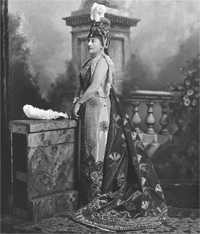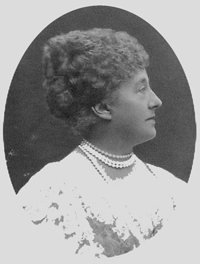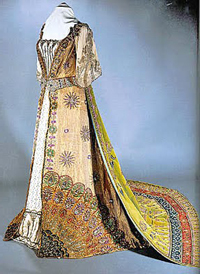Louise, Duchess of Devonshire,
In her youth, Louise, as the wife of the Duke of Manchester, was termed “the most beautiful wife in England”. As the young wife newly-arrived in England, Queen Victoria expressed a wish to meet her, and then wrote to her daughter, later Empress Frederick of Germany, “As for her beauty, I admire her profile very much; the front face much less – and I fear it will not last. The waist and throat are too short for me to admire her figure.” Louise bore the Duke of Manchester five children and carried on a thirty year affair with the Duke of Devonshire, only marrying him in 1892 - after two years of widowhood. This gave rise to her sobriquet “the double duchess”. As one of the most powerful and wealthiest political hostesses in London and a leader of the type of society so despised by Queen Victoria, her decision to hold the celebration par excellence for the Diamond Jubilee was not devoid of irony. For her costume, the Duchess commissioned Monsieur Comelli (1858-1925), a well-known designer of opera costumes for the London theatre and opera stage, and then had the design made up by Worth of Paris. Munsey’s Magazine noted “it is safe to say that the Queen of Palmyra never owned such a sumptuous costume in her lifetime.” The role chosen, was rather appropriately, that of Zenobia, Queen of Palmyra - a character who had re-entered Western consciousness in mid-17th century, and was the subject of over 20 Italian operas over the next two centuries. However, it would have been the journey of Lady Hestor Stanhope, the English traveller to Palmyra in 1814, and the account of Palmyra by Lady Isobel Burton which made Zenobia familiar to the British. Monsieur Worth must have been given free rein to work outside a budget and the ensuing creation consisted of a skirt of gold tissue, embroidered all over in a starburst design in emeralds, sapphires, diamonds, and other jewels outlined with gold. This opened to show an underdress of cream crêpe de chine, embroidered in silver, gold, and pearls and sprinkled all over with diamonds. The train, fastened at the waist with a large diamond ornament, was of green velvet and highly embroidered with lotus flower in rubies, sapphires, amethysts, emeralds and diamonds. The gold crown was incrusted with emeralds, diamonds and rubies, with a diamond drop at each curved end and two white ostrich feathers in the middle. Round the front were festoons of pearls with a large pear-shaped pearl in the centre falling on the forehead. This costume is the only known costume to have survived from the Ball and forms part of the collection of the present Duchess of Devonshire at Chatsworth House.
|
Click on image to enlarge
|
||
|

 V&A Lafayette Archive
V&A Lafayette Archive
